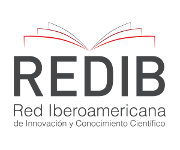Simulation and evaluation of ad hoc networks under different mobility models
Simulación y evaluación de redes ad hoc bajo diferentes modelos de movilidad
DOI:
https://doi.org/10.15446/ing.investig.v23n3.14705Keywords:
Ad hoc networks, mobility model, ns-2 performance, protocol, simulation (en)redes ad hoc, modelo de movilidad, ns-2, desempeño, protocolo, simulación (es)
Downloads
In the performance evaluation of a protocol for an ad hoc network, the protocol should be tested under realistic conditions including realistic movements of the mobile users (a mobility model). In this paper we revise several mobility models used in the simulations of mobile networks including mobility models that represent mobile nodes whose movements are independent of each other and mobility models that represent mobile nodes whose movements are dependent on each other (group mobility models). We present simulation results in NS-2 that illustrate the importance of choosing a mobility model in the simulation of a mobile network protocol. Specifically, we illustrate how the performance results of an ad hoc network protocol drastically change as a result of changing the mobility model simulated.
En la evaluación del desempeño de un protocolo para una red ad hoc, el protocolo debería ser probado en condiciones realistas, incluidos movimientos realistas de los usuarios móviles (un modelo de movilidad). En este artículo se revisan varios modelos de movilidad usados en simulaciones de redes móviles, incluidos modelos de movilidad que representan nodos móviles cuyo movimiento es independiente de los otros nodos móviles y modelos de movilidad que representar nodos móviles cuyos movimientos son dependientes de los otros (modelos de movilidad de grupos). Se presentan algunos resultados de la simulación en NS-2, que ilustran la importancia de escoger un modelo de movilidad en la simulación de un protocolo sobre redes móviles Específicamente, se ilustra como los resultados de desempeño en una red ad hoc cambian drásticamente al cambiar, bien sea el modelo de movilidad, o bien los parámetros del modelo seleccionado o ambos.
References
Tanenbaum, A.S, (1996). “Computer Networks", Prentice-Hall,
The CMU Monarch Project. The CMU monarch extensions to the ns simulator. URL: http://www.monarch.cs.cmu.edu/. Page accessed on January 5th, 2001.
Broch, J.; Maltz, D.A.; Johnson, D.B,; Hu, Y.C., and Jetcheva, J. (1998). A Performance Comparison of Hulti-Hop Wireless Ad Hoc Network Routing Protocols. In Proc. of the ACM/IEEE MobiCom.
Chiang, C., and Gerla, M. (1998). On-demand multicast in mobile wireless networks, In Proceedings of the IEEE International Conference on Network Protocols (ICNP).
The network simulator - ns-2. http://www.isiedu/nsnam/ns/, 2002.
Bar-Noy, A; Kessler, I., and Sidi, M. (1994), Mobile users: To update or not to update? In Proceedings of the Joint Conference of the IEEE Computer and Communications Societies (INFOCOM), pages 570-576.
Basagni, S.; Chlamtac, I.; Syrotiuk, V.R., and Woodward, B.A. (1998). A distance routing effect algorithm for mobility (DREAM). In Proceedings of the ACM/IEEE International Conference on Mobile Computing and Networking (MOBICOM), pages 76-84. DOI: https://doi.org/10.1145/288235.288254
Boleng, J. (2201). Normalizing mobility characteristics and enabling adaptive protocols for ad hoc networks, In Proceedings of the Local and Metropolitan Area Networks Workshop (LANMAN), pages 9-12.
Broach, J.; Maltz, D.; Johnson, D.; Hu, Y, and Jetcheva, J. (1998). Multihop wireless ad hoc network routing protocols. In Proceedings of the ACM/IEEE International Conference on Mobile Computing and Networking (MOBICOM), pages 85-97. DOI: https://doi.org/10.1145/288235.288256
Brown, T.X. Personal correspondence. April 2001, [7] T. Camp, J. Boleng, B. Williams, L. Wilcox, and W. Navidi. Performance evaluation of two location based routing protocols. In Proceedings of the Joint Conference of the IEEE Computer and Communications Societies (INFOCOM), 2002. To appear.
Chiang, C, (1998). Wireless Network Multicasting. PhD thesis, University of California, Los Angeles.
Chiang, C., and Gerla, M. (1998). On-demand multicast in mobile wireless networks, In Proceedings of the IEEE International Conference on Network Protocols (ICNP).
Davies, V. (2000). Evaluating mobility models within an ad hoc network. Master's thesis, Colorado School of Mines.
García-Luna-Aceves, J.J., and Madrga, E.L. (1999). A multicast routing protocol for ad-hoc networks. In Proceedings of the Joint Conference of the IEEE Computer and Communications Societies (INFOCOM), pages 784-792. DOI: https://doi.org/10.1109/INFCOM.1999.751466
García-Luna-Aceves, J,J., and Spohn, M. (1999). Source-tree routing in wireless networks. In Proceedings of the 7th international Conference on Network Protocols (ICNP). DOI: https://doi.org/10.1109/ICNP.1999.801950
How to Cite
APA
ACM
ACS
ABNT
Chicago
Harvard
IEEE
MLA
Turabian
Vancouver
Download Citation
License
Copyright (c) 2003 Jorge Eduardo Ortíz Triviño, Jaime Leonardo Bobadilla Molina, Miguel Arnulfo Saumett León

This work is licensed under a Creative Commons Attribution 4.0 International License.
The authors or holders of the copyright for each article hereby confer exclusive, limited and free authorization on the Universidad Nacional de Colombia's journal Ingeniería e Investigación concerning the aforementioned article which, once it has been evaluated and approved, will be submitted for publication, in line with the following items:
1. The version which has been corrected according to the evaluators' suggestions will be remitted and it will be made clear whether the aforementioned article is an unedited document regarding which the rights to be authorized are held and total responsibility will be assumed by the authors for the content of the work being submitted to Ingeniería e Investigación, the Universidad Nacional de Colombia and third-parties;
2. The authorization conferred on the journal will come into force from the date on which it is included in the respective volume and issue of Ingeniería e Investigación in the Open Journal Systems and on the journal's main page (https://revistas.unal.edu.co/index.php/ingeinv), as well as in different databases and indices in which the publication is indexed;
3. The authors authorize the Universidad Nacional de Colombia's journal Ingeniería e Investigación to publish the document in whatever required format (printed, digital, electronic or whatsoever known or yet to be discovered form) and authorize Ingeniería e Investigación to include the work in any indices and/or search engines deemed necessary for promoting its diffusion;
4. The authors accept that such authorization is given free of charge and they, therefore, waive any right to receive remuneration from the publication, distribution, public communication and any use whatsoever referred to in the terms of this authorization.



























